Category — Taking on challenges
Everything weighs something
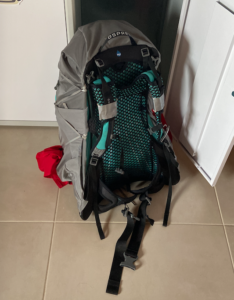
It didn’t occur to me until the fourth day of walking the Camino when my (ever-so-carefully-chosen) super-lightweight backpack with its (ever-so-carefully-chosen) super-lightweight contents started to cause a deep bone ache in my left shoulder blade. I was unpleasantly—painfully—surprised. I had spent a lot of time thinking about and researching what to take on this 500-mile journey. I paid strict attention to grams and ounces, choosing a rain jacket I didn’t really like that much over one I did because it weighed two ounces less. I bought an ultra-light sleeping bag that closed with little plastic snaps rather than a weighty (as in 3.5 oz.) zipper.
I was relentless, obsessive. I parceled out three band-aids for my first aid kit instead of including a small box. I cut my toothbrush in half. Oh yes I did. Every individual item I chose to put in that backpack–everything I firmly believed (or was told on countless helpful websites) I would need for the journey—I chose by weight.
But…everything weights something. And all those somethings add up. All those somethings, together, were a big something. This came as an ah-ha moment four days in. It doesn’t sound like much of a revelation. But it felt like one to me as I wrapped the shoulder strap of my backpack in the moleskin I was carrying to treat the blisters I never got.
One of the things about walking every day for fifteen, eighteen, occasionally twenty miles—and then getting up and doing it again, and again, for 36 days—is that the monotony of the physical act frees you to think big thoughts. (Or sometimes no thoughts at all. )
And so, when “everything weighs something” popped into my head, I began to think big thoughts, like: Okay, this is not just about the damned backpack. It is about life. About the weight we carry. All those little somethings.
Sure, we are aware of the burden when something big happens: disease, death, divorce. That is heavy luggage. But we are often unaware of the collective weight of the many little things. That thing we should have said but didn’t. That thing we said but shouldn’t have. That misunderstanding that was never cleared up. That time someone disappointed us. That time we disappointed someone. That time we needed a little help and didn’t get it. That time we needed a little help and didn’t ask for it. That look. Oh, that look. The little slings and arrows. We stuff them away.
But they add up. And then, one day, we feel the weight.
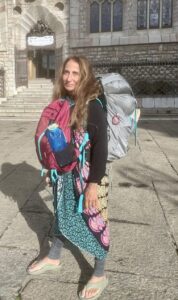
November 23, 2022 6 Comments
Signs along the way
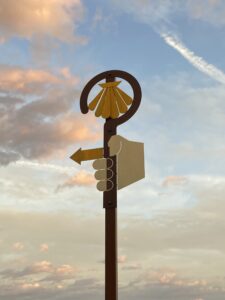
As you are going along The Way (and by The Way, I mean The Way of St. James, the Camino de Santiago), you see signs. Some are obvious. They boldly announce that you are on the right path. Or they unmistakably point you in the direction you need to take.
On the Camino these can be big, brilliant yellow arrows, or turquoise blue signs with canary yellow clamshells, or concrete waymarkers with kilometer counts. Sometimes these signs are eye-level and hard to miss. Sometimes they are painted on the sides of barns or fences or stone walls, faded, barely visible. Sometimes they are little plaques embedded in the road, easy to miss unless you are looking down.
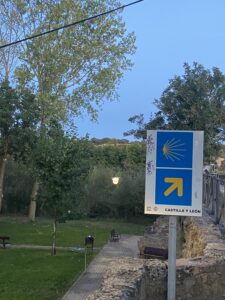
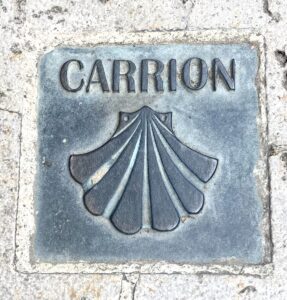 Sometimes, especially in Galicia, these signs greet you so often that you stop seeing them. Other times you can go a long way without seeing a sign, and you are concerned that you have lost the way, and just as that concern is about to turn to worry or even into something darker, you see a sign. The relief borders on exaltation.
Sometimes, especially in Galicia, these signs greet you so often that you stop seeing them. Other times you can go a long way without seeing a sign, and you are concerned that you have lost the way, and just as that concern is about to turn to worry or even into something darker, you see a sign. The relief borders on exaltation.
And then there are the times you see no sign at all, but you see a person walking way ahead on the road, or you see the light of their head lamp. Although you may never catch up, never know who this person is, you feel gratitude and friendship. This happened to me along the Camino a number of times when I started alone in the pre-dawn hours. It brought to mind that E.L. Doctorow quote I am so fond of that I have used it in just about every talk I’ve ever given about the process of writing: “Writing is like driving at night in the fog. You can only see as far as your headlights, but you can make the whole trip that way.”
And that, really, is how I made my way: from sign to sign, by the light of my head lamp, by the distant light of someone else’s. Seeing just what needed to be seen to take the next step.
Now two weeks home, I am thinking: I wish life was like the Camino and every so often, just when you needed it, there was a sign to tell you, to reassure you, that you were on the right path. And then I think: Maybe life is like this, but we don’t know what the signs are, or we ignore the signs, or we are just looking elsewhere.
November 16, 2022 15 Comments
The Way
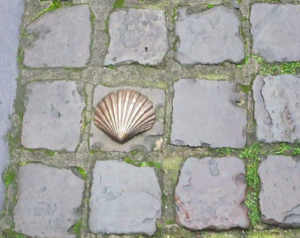
In two days I will begin making my way on The Way. That’s the Way of St. James, a network of 1000-year-old Christian Pilgrimage routes that starts at the foothills of the Pyrenees in St. Jean Pied-de-Port and ends at the Cathedral of Santiago de Compostela, where the remains of St. James are enshrined. Probably not his skull bones. (He was beheaded in Jerusalem by King Herod in 44AD.)
The hiking/ walking route meanders through high mountains and deep valleys, undulating plains, vast olive groves, the Basque country, the vineyards of Rioja, the Meseta flatlands, the green rolling hills of Galacia. Small villages dot the landscape. Very occasionally there is a town of some size, notably Pamplona (of Hemingway and bull-running fame). If this sounds like I know what I’m talking about, I don’t. I am parroting brochure language. But soon I will know. For the next 30-40 days I will live this, hiking through it, seeing what I have never seen before, meeting fellow travelers, eating communal meals (and tapas at every opportunity), sleeping in rooms with bunk beds next to snoring, farting strangers. And get up the next morning and do it again.
When I have told friends that I would be doing this, I encountered two reactions. The first “oh this is on my bucket list!” I don’t have a bucket list. I don’t like the whole notion of a bucket list. But if I did have a bucket list, the Camino would not have been on it. I knew zero about the Camino—I mean I didn’t know of its existence—until I crossed paths two years ago with the documentarian Lydia Smith, director of “Walking the Camino.” It’s a beautiful film. I watched it (as you should too) and didn’t think about the Camino again until after Tom died. Then it occurred to me that this journey was just the kind of deep, immersive, solitary adventure I needed and wanted. Also, Tom never ever in a godzillion years would have wanted to do this. So I would not have to bear any “I wish he were here to share this” thoughts.
The second reaction when I told friends I was going off on this adventure was: “You’re going to write about this, right?” Well, that is what I do. So yes, I am. But in what way, in what form, I do not know. I will find my Way.
September 21, 2022 7 Comments
Resilience
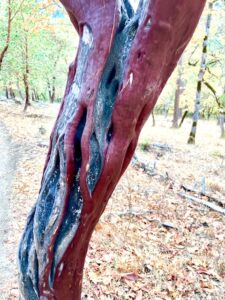
You trip over a fallen log and gash open your leg on a spiky branch. And by “you” I mean me. And the wound is cleaned and stitched, and you heal. You’ll have a scar but big deal. The body is resilient. The body knows what to do. Would you have healed faster when you were younger? Yes. It is true. The older we are, the slower we heal. Physically.
Or you go for a long run or a hard hike. And by “you” I mean me. And maybe the next morning you feel it. So you’ll be a little sore. Big deal. The body is resilient. The body knows what to do. Would you have recovered faster when you were younger. Yes, it is true. The older we are, the longer it takes to bounce back.
But there is a kind of recovery that grows stronger with age, and it is more important than physical mending. It is emotional resilience. It is the ability to cope with and respond to setbacks and challenges, to unwelcome changes, to losses. To, you know, Life with a capital L.
When I was thirteen, Myles Cooley, my first boyfriend, my first love, the first boy I kissed, dumped me. I was devastated in a way I still remember. My heart ached. I cried. Every song on the radio was about love. So I cried some more. At that age, I had zero tools in my emotional resilience toolbox. I thought about him for years, yes years, afterward. I did not give my heart away (as a teen girl would put it) until I met my college boyfriend five years later.
But time and circumstance are good teachers. You learn. And by “you” I mean me. You develop problem-solving skills. You acquire coping strategies. You learn how to manage your emotions. You nurture what psychologists call an internal locus of control, that powerful belief that your actions can affect the outcome of events. This imbues you with a sense of confidence and control. You learn that you are a survivor.
You didn’t know any of this when you were thirteen.
Now you do.
And, although there is toughness that comes from this learning, there is also buoyancy.
Photo (mine): Madrone bark, Lithia park, Ashland
September 14, 2022 1 Comment
I Dream of Tommy
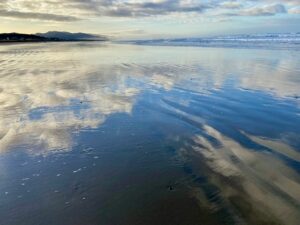
I had a dream last night. Of course I did. We dream every night. But I have not remembered a dream since October 15, the day Tom died. This morning I awoke with this dream image: My friend Jón Ágúst Guðjónsson, an Icelandic shaman, was operating a huge piece of earth-moving machinery, piling a mound of rich earth in the meadow in front of my house. Tom was perpetually amused at how literal and transparent my dreams were. Uh, yeah. So, Tom, out there, ANALYZE THIS!
I wrote that (and posted it on Facebook) last week. I tagged Jón Ágúst, who immediately responded “I look forward to see if Tom sends clues about the meaning in the next few days.” That’s like, shaman talk, way above my pay grade. My view of dreams, which was nourished and enriched by many talks with Tom over the years—his being nourished and enriched by a Jungian dream group he was a part of for close to a decade—is that dreams are a way for one part of you to communicate to another part of you. To send messages, alerts, prompts, pings. Subconscious to conscious. The stuff buried, ignored, unexplored. Free from the external stimuli (not to mention ego) of daily waking life, the subconscious takes over when we sleep. Dreams are often an intriguing mixture of “real” images—people and places you know, snippets of movies, memories—and images or story lines that seem random (hardly ever!) or difficult to interpret (not for me).
So I spent time with that dream, which to me was about (literally) unearthing what needed to be unearthed, about Pachamama sending me a clear signal: Take this dirt, this earth and make something new. Grow something. Make a new landscape with it. Okay: Got it.
But what Jon Agust was talking about was the dream world as a conduit between the living-on-earth (me) and the no-longer-living-on-earth (Tom). That was a little too séance-y for me, thank you very much.
And then, boom. The very next night, I had this dream: I was dancing ecstatically in the meadow (yes, same meadow) with Henry, the one-and-a-half-year-old newest member of our family. As I flung my arms around, I felt that my wedding ring flew off my finger. I panicked. But when I looked down at my hands, I saw that my wedding ring was still there. It was Tom’s wedding band, which I have been wearing on the middle finger of my right hand, was gone. I scoured the meadow. Saw nothing. Hunted desperately. Then, giving up, I walked back to where Henry and I had been dancing. I sat down on the grass. I turned my head, and there, right next to me was his ring.
Yeah. So Tom sent that message.
We had talked about whether we would be able to communicate after he died. The whole idea seemed so 1990 Ghost-y, so weird. But everything was so weird already that the conversation seemed rational. I wanted that dream to mean that Tom had found a way to reach out to me, and that I was receptive. But I had my doubts.
And then, the next night, this dream: I am driving my car and realize I don’t know how to get to my destination. My nav system doesn’t work. Fine, I love maps. I stop the car, open the glove box and look for a map. There is no map. For a moment, I think: Shit. I’m screwed. And then, just as suddenly, I am filled with…some combination of curiosity and energy and joy. I get to make this up. I get to find my way.
Thanks, T.
(photo credit: ME)
January 14, 2022 8 Comments
Goodbye to all that
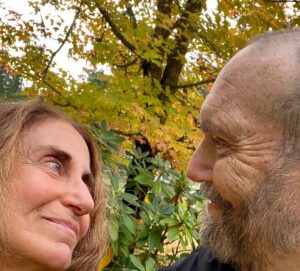
Surrender with grace. That’s what the yoga teacher said as we were settling into a difficult posture. This not something I do very well, this surrendering thing. And rarely with grace. But it is what Tom did, was brave and strong and wise enough to do. Was allowed to do because we live in Oregon.
I am referring to his decision to make use of Oregon’s Death with Dignity. We talked about it back when it was first enacted twenty-four years ago, two vibrantly healthy people with a houseful of small children and busy, active lives. We supported it, embraced it, were proud of our state for enacting such a deeply thoughtful, empathetic approach to end of life. Years later, when California voters had an opportunity to vote on similar legislation, I wrote a long piece for the LA Times that chronicled the deaths of two men, an Oregonian with the choice to make a dignified exit and a California man forced to contemplate illegally stockpiling pills or putting a pistol in his mouth.
Our discussions were theoretical, political, medical. But not really personal. Or they were personal only in the sense that we both said, yes, this is how we would want to go. But we didn’t think we would actually, you know, go. We didn’t actively contemplate our own demise. Why should we? In the words of Tom Petty, the future was wide open.
Until it wasn’t.
He didn’t surrender immediately. Of course he didn’t. He did the research. He was beyond qualified to do the research, to deep-read, parse and understand the studies. He chose his doctor wisely. He had surgery, radiation, powerful (need I add debilitating) rounds of chemotherapy. There were good days, good weeks. There were carefully planned trips, not as adventurous as we were used to, but still adventures. And then there was more research, and an attempt at another treatment. And then, suddenly—it seemed suddenly although it was a year in coming—there was nothing left to do except to sit on the back deck facing the weakening autumn sun and surrender.
Him, not me. He read Lao-tzu and watched the leaves turn orange on the sugar maple. He listened to the jays that circled the bird feeder. He napped and dreamed and talked about his dreams. Me? I worked my way through prodigious to-do lists. I made soup. I finished a writing project for him. I bought high-quality linen for the awful hospital bed that was now center stage in our living room. I searched online for slippers to fit his swollen feet. I kept doing because to stop doing meant I was giving up. Notice I use “giving up” instead of “surrendering.”
His exit that Friday evening in mid-October, with me and the children encircling the bed, was not about giving up. It was powerful. It was intentional. It was graceful. It was ceremonial. It was, in a way that only those who witness such moments can understand, magical. I will learn from this.
(The image is a double-selfie I took in the backyard the day before Tom chose to leave.)
December 3, 2021 32 Comments
A Nutcracker-less Year
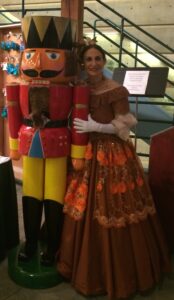
Maria Tallchief danced the Sugar Plum Fairy. Andre Eglevsky was the Cavalier. It was my first Nutcracker. I was five. I had no idea who they were or how incredibly lucky I was to be in that audience. All I knew was: WOW. All I knew was: I WANT TO DO THAT.
My mother, who took me to that performance and to Nutcrackers for the next thirteen seasons, understood. I started ballet lessons with Professor Troyanoff (who may or may not have been an actual professor) when I was six. When I was almost eleven, I began taking lessons from Andre Eglevsky, (yes, him) who had just retired from Balanchine’s New York City Ballet. At twelve, I was–as the saying goes–drummed out of the corps. Eglevsky told my mother to stop wasting her money. I had the wrong body. I would never be a dancer.
What those words did to me, and what I did to recapture the dream I had of dancing in The Nutcracker became my book, Raising the Barre. I had to write it.
This is my first Nutcracker-less year (either in the audience or on stage) since I was five. I miss it terribly. In this year of missing so much, this is near the top of the list.
And so I am listening to Moscow Symphony Orchestra’s production of Tchaikovsky’s sumptuous score as I post these images of my time with the talented, hard-working, generous and oh-so-kind Eugene Ballet Company dancers who inspired me, taught me, and let me into their lives.
Stretching out in company class
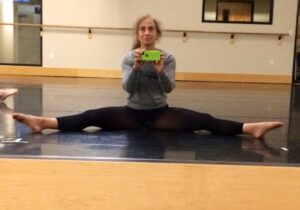
The ever-patient Mark Tucker (in background) and his partner in dance and life, Danielle Tolmie, taught me the Grandfather Dance (my 15-seconds of center-stage glory).
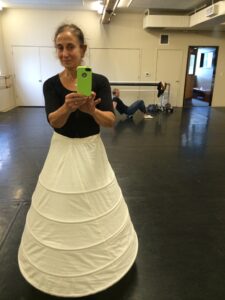
The glamor (not) and excitement of the backstage dressing room. (That’s Victoria Harvey, who took me stage make-up shopping. Suzanne Haag taught me the magic.)
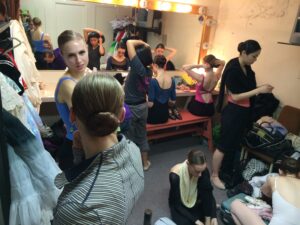
Warming up before a Hult Center performance
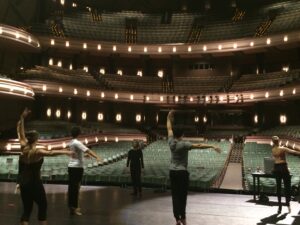
My friend, wing-woman, Ballet Book Club and leotard-shopping partner, Kim Sheehan.
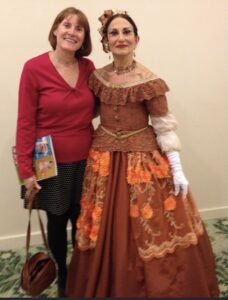
December 20, 2020 1 Comment
In praise of The Bubble
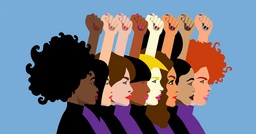
“You’re just in your own little bubble.”
This is offered as an insult. A bubble is bad thing. Being in a bubble implies (well, more than implies) that you purposely and exclusively surround yourself with people who think, talk, live and look like you, your political, cultural, religious, economic, racial, gender-identified bedfellows.
The bubble is, by this definition, an unchallenging, unmotivating place, a somnambulant comfort zone that you share with fellow bubble-dwellers. Or maybe it’s just your own private world, isolated and insulated from what is happening all around you. A bubble by this definition is solipsistic, self-involved. Those who reside inside it are resistant to acknowledging, reaching out, getting to know and working to understand the “other.”
Maybe.
I mean, yes, a bubble can be all that. But I’d like to argue for another kind of bubble. Especially during the past four dark, nasty, soul-crushing years, I have sought out and immersed myself in a bubble. My bubble is not geographic—although living on the “upper Left coast” sure helps. It is not age-specific. The bubble includes people from 26-81 years old. It is not race-specific. The bubble includes people of many hues. Some in this bubble I have known for most of my life. Others are newcomers. Some, most, I know IRL. Others I have connected and bonded with over social media.
What we have in common, what has sustained me these past four years, is our commitment to social justice and meaningful change, our love of our communities and our work to keep those communities vibrant, our persistent and stubborn belief (sometimes to the contrary of all we see) that people are good and want to do good and do indeed care about each other. What we have in common is our resilience. When during these past few years more shit hit the fan than anyone knew there was shit out there, we were appalled, we were furious, we yelled, we cried. And then we took a breath, gave ourselves a talking to, reached out and jumped back into it. That meant everything from taking to the streets to cooking food for the hungry, from running for political office to helping find jobs for the previously incarcerated, from making music to sewing masks. And more. So much more.
I owe my sanity to this bubble. I thank you all. You know who you are.
In memory of, in praise of RBG. Of course.
November 18, 2020 2 Comments
(grand)Motherhood 2.0

All of a sudden, I am one: a grandmother.
Well, perhaps not “all of a sudden.” It involved one of my children intertwining lives with an extraordinary partner, and then these two extraordinary people deciding to make another human. And then there were those forty-some-odd weeks during which two cells grew into Henry.
So what is a grandmother these days? Who am I as a grandmother?
I think of my own grandparents. On my father’s side was Anna, an immigrant, poor, illiterate. Her husband died before my parents met. He was, I think, a day laborer. No one talked about him as I was growing up. Much later my uncle told me he was a wife-beater. Anna had suffered from crippling arthritis since she was 16. Her hands were claw-like and her knees were heavily bandaged. She lived in a dark apartment in an old building in a marginal neighborhood that today is busting at the seams with kombucha-drinking visual artists.
I have no memory of her ever visiting our house. We visited her, a once-a-month (or less) chore considered by all an unpleasant experience. She was cranky and nasty, undoubtedly due to constant pain, the trauma of her marriage, the dreariness of her life. None of which I realized at the time. To me she was an old old lady (she would then have been about my age) who lived in a dank, smelly apartment and made terrible food we were forced to eat. I remember her night table crammed with prescription medicine bottles. I was petrified when she touched me with those claw-hands.
My maternal grandparents were a sweet pair, my loquacious Nanny and my quiet, dreamy grandpa. They were not a big part of my life, not even really a small part of my life. This was for two reasons: One, my father hated them (as he hated all of my mother’s family) and two, they moved to the Promised Land (aka California) when I was seven. I remember one, and only one, time when I was solely in their care. They were at my house–my parents were off somewhere, perhaps making my brother—and my grandmother bought me a package of Hostess snowballs. Those were the round little cakes covered in marshmallow and coconut. And pink. My mother would never have let them into the house. I remember sitting at the kitchen table, peeling off the marshmallow covering, rolling it into a ball in my palms and then bouncing it off the wall. My grandmother laughed. At that moment, I could not have loved her more. But then they moved 3,000 miles away. And we visited once.
I know those ironic images of grandmas. We all do: iron-gray hair in tight curls, alternately baking cookies and knitting scarves, kindly, crinkly-eyed, bosomy women. In aprons. Not my grandmas. And, needless to say, not me.
There is also today (and for at least the past generation that includes my own parents as grandparents) a vast population of distant and disconnected grandparents whose kids moved across the country or across the ocean. Visits are infrequent and are “occasions.” Or it may be that their own lives—divorces, remarriages, stepkids and step grandkids, second careers—stretch them too thin to be involved/ in the moment grandparents. Again, not me.
So I know what I am not.
What am I? I don’t know yet.
But I do know I will be there, part of everyday life, familiar, open-armed, open-hearted, a hugger, an on-the-floor-playing partner, a doer, a laugher, a listener. And there might be cookies.
Grandmotherhood 2.0, bring it.
August 26, 2020 7 Comments
To ACT is to FOCUS
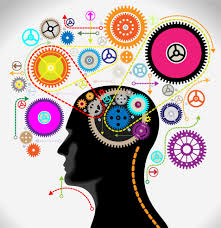
You know—don’t you?—that multi-taking doesn’t work.
The brain is not capable of simultaneously performing two or more tasks that require our focus and attention. Instead, a kind of toggle mechanism allows the brain to switch from one task to another. The switch is rapid, so you think you’re doing two things at once and oh-so productive, but you aren’t and you’re not. In fact, toggling leads to errors, and the tasks take more time than if you were to focus on each individually. Toggling also, over time, leads to a special kind of exhaustion. As all of us supposed multi-taskers know.
Why am I writing about this now?
Because all of us who care deeply about and want to be meaningfully involved in the crucial issues of the day have been forced into exhausting, debilitating—and inefficient—multi-taking. We are so overwhelmed with what is wrong, with what needs our attention, with what we need to learn more about, with how to be part of the struggle(s) and the change(s), that our brains are toggling toggling toggling.
Our focus shifts from moment to moment: another outrageous statement by the man in the White House, another heart-stopping virus statistic, another video of federal troops in city streets, Russian hackers, white supremacists. And then there are those concerns we had, those fights we were fighting, before all this. Remember climate change? Criminal justice reform? Homelessness? Food insecurity?
Like you, I am overwhelmed.
I cannot do everything.
I cannot do nothing.
I must do something.
And to DO something, I must focus. I must put a stop to all this exhausting and inefficient toggling. I invite you, even just for the next 24 hours, to do the same.
What is helping me focus today on an issue I care deeply about (one that intersects with race, COVID and MOTUS—that’s the acronym for Monster of The United States) is this new album by my fellow Food for Lane County Dining Room volunteer, Steve Gibson. He wrote the songs beginning in 2011 when he started volunteering. They tell of the people he met and his own efforts to stay in the fight, to do the work. (It’s the final song on the album, Compass.)
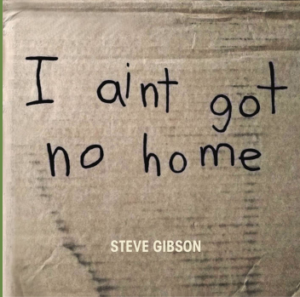
Here’s the link to the album. All proceeds go to Food for Lane County.
And here’s the link to Steve’s live performance tomorrow (Thursday, 7 pm Pacific).
Listen. Contribute if you can.
We can’t do everything. But we can FEED ONE PERSON who would normally go hungry. That is what we can do today.
July 22, 2020 No Comments





